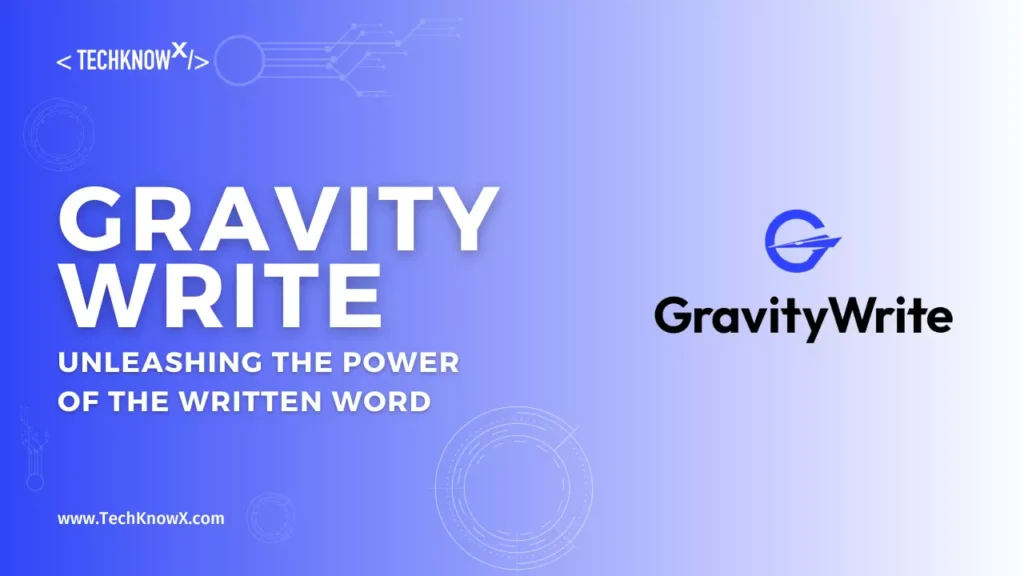Master the art of persuasive and engaging content creation with Gravity Write. Discover the power of storytelling and persuasive language.

Introduction
In a world driven by digital content, the art of effective writing has become more crucial than ever. Your online presence might succeed or fail based on your ability to write properly, whether it’s for blog entries, website material, or social media updates. This essay looks into the idea of “gravity write,” examining its implications, methods, and advantages in the current digital environment.
1. What is Gravity Write? 🤔
The idea of “Gravity Write” combines both the art and science of creating compelling material. It entails applying a variety of tactics and strategies to produce material that grabs, holds, and engages readers. Gravity Write goes beyond mere words on a page; it aims to create a gravitational pull that keeps readers hooked from start to finish.
2. The Elements of Gravity Write
2.1 The Art of Storytelling
Storytelling is one of the core components of Gravity Writing. Stories are a very effective strategy for grabbing and retaining attention because humans have an innate connection to tales. You can make your material more approachable, memorable, and emotionally engaging by incorporating fascinating stories into it.
2.2 Emotional Connection
Gravity Write understands how critical it is to engage readers on an emotional level. Individuals are more likely to interact with stuff that makes them feel something. By appealing to their desires, fears, aspirations, or even sense of humor, you can establish a deeper connection and make your content resonate on a personal level.
2.3 Persuasive Language
Effective persuasion is a key aspect of Gravity Write. Choosing the right words, employing rhetorical devices, and using persuasive techniques can help sway readers’ opinions and encourage them to take action. You may increase the persuasive power of your material by knowing your target audience and speaking to them in a manner that suits their needs and preferences.
3. Crafting Irresistible Headlines
Headlines play a vital role in capturing readers’ attention and enticing them to click on your content. A well-written headline should be succinct, and captivating, and clearly state the value or advantage readers can anticipate from continuing to read. It should pique their interest and entice them to explore your stuff.
4. Keywords and SEO Optimization
To maximize the reach and visibility of your content, incorporating relevant keywords is essential. To determine the words and phrases that your target audience is looking for, conduct a thorough keyword study. Use these keywords strategically throughout your material, in headings, subheadings, and the text’s body. But, make sure the keywords make sense and do not detract from the writing’s readability or general quality.
Additionally, optimizing your content for search engines involves other SEO practices. These include writing meta descriptions, creating descriptive URLs, using alt tags for images, and building quality backlinks. You may raise the position of your content on search engine result pages and drive organic traffic to your website by adhering to SEO best practices.
5. Creating Engaging Introductions
The introduction of your content sets the stage for what follows and plays a crucial role in capturing readers’ attention. A strong opening paragraph should be succinct, informative, and spark the reader’s interest. Start off your speech with a provocative question, an eye-opening statistic, or an engaging tale. You may encourage visitors to read on and explore the rest of your content by giving them a compelling hook in the beginning.
6. Structuring Your Content
Properly structuring your content is essential for readability and comprehension. Utilizing appropriate heading tags (H1, H2, H3, and H4) helps organize your content and provides a clear hierarchy of information. Let’s explore the significance of each heading level:
6.1 H1: The Power of Heading 1 Tags
The H1 tag represents the main heading of your content and should succinctly summarize the overall topic.It serves as a signpost for readers, indicating what they can look forward to in the sections that follow. Also, when evaluating the relevance and context of your content, search engines heavily weight the H1 tag.
6.2 H2: Subheadings That Guide the Reader
H2 headings divide your content into meaningful sections, allowing readers to navigate through the different subtopics. The substance of each part should be summarized in these subheadings in a clear and succinct manner so that readers know what to expect. They also help your content’s overall readability and organization.
6.3 H3 and H4: Breaking Down Complex Ideas
H3 and H4 headings are used to further break down complex ideas or provide additional subheadings within H2 sections. They facilitate information organization, improve readability, and simplify material scanning for readers. Use these headings sparingly, and make sure they are valuable by outlining the main ideas or providing evidence for them.
7. Using Visuals to Enhance Your Content
Images, infographics, and videos are examples of visual features that can greatly increase the impact and engagement of your content. Visual elements such as images, infographics, and videos can significantly enhance the impact and engagement of your content. The text is broken up into images, which improves its aesthetic appeal and makes it simpler to read. Also, they offer a chance to deliver information in a new format, accommodating various learning preferences and styles. When employing graphics, make sure they are pertinent, of excellent quality, and, if necessary, correctly acknowledged.
8. Maintaining Readability and Flow
While crafting your content, prioritize readability and flow. Use clear and concise sentences, avoid excessive jargon, and break up paragraphs to create white space. Make sure that your information flows logically from one section to the next by paying attention to its general arrangement. You can help readers understand your content and continue to be interested in your writing by keeping it readable.
9. Incorporating Personal Pronouns
Writing in a conversational style often involves incorporating personal pronouns. By using pronouns such as “you” and “we,” you create a sense of direct communication with the reader. By making the text more relatable and creating a connection, readers will feel more interested and engaged. It encourages a welcoming and approachable tone, which can improve the reading experience as a whole.
10. The Active Voice: A Call to Action
Using the active voice in your writing adds strength and clarity to your sentences. It allows you to communicate your ideas more directly and assertively. The active voice places emphasis on the subject performing the action, which can create a sense of urgency and encourage readers to take action. By utilizing the active voice, you make your content more persuasive and compelling.
11. Keeping It Simple: Avoiding Jargon
It’s crucial to keep information basic and refrain from overusing jargon or technical phrases when composing it. Keep in mind that your viewers might not be subject-matter specialists. Strive to deliver your message in a way that is understandable and straightforward. Make sure your material is inclusive and relatable to a large audience by using simple, understandable language.
12. Engaging the Reader: Rhetorical Questions
Powerful tools for enticing readers and provoking their thinking are rhetorical questions. You stimulate readers’ thinking by presenting perplexing questions about the subject at hand. Readers who are looking for solutions may become more interested in your material as a result of rhetorical inquiries.
13. The Power of Analogies and Metaphors
Analogies and metaphors are powerful tools that can elevate your writing to new heights. They make it possible for you to communicate intricate ideas and concepts in a way that is more approachable and clear. Analogies and metaphors help your readers visualize your ideas clearly by making connections between unfamiliar situations and abstract topics.
Analogies involve contrasting two distinct objects to show patterns or similarities. For instance, you may contrast the complex operation of a watch with the complexity of an effective website. This comparison aids readers in understanding the rigorous attention to detail necessary to have a successful web presence.
On the other hand, metaphors directly compare two unconnected objects. They arouse feelings and establish associations. For instance, you could emphasize the difficulties and uncertainties a company faces by comparing it to a “ship traversing uncharted waters.” By the use of metaphors, you may emotionally connect with readers and increase the recall of your writing.
Always keep in mind your audience as well as the context of your work when employing analogies and metaphors. Choose illustrations that will help your audience better understand the subject. To preserve the impact of your analogies and metaphors, be imaginative and use them selectively.
By incorporating well-crafted analogies and metaphors, you can enrich your content, make it more engaging, and leave a lasting impression on your readers.
14. Conclusion: Elevate Your Writing with Gravity Write
The written word’s influence in today’s digital world cannot be understated. The art and science of producing interesting, convincing, and engaging material are both covered by Gravity Write. You may make the most of your writing by using storytelling, emotional connection, and persuasive language.
Crafting irresistible headlines, optimizing your content for SEO, and creating engaging introductions are essential steps in capturing readers’ attention from the start. Structuring your content with appropriate heading tags, utilizing visuals, and maintaining readability and flow are crucial for keeping readers engaged throughout.
Your writing will be more relatable and understandable if you use personal pronouns, the active voice, and stay away from jargon. Your information will have more depth and resonance if you use metaphors and analogies as well as rhetorical questions to engage the reader.
You have the ability to elevate your writing from ordinary to outstanding by embracing Gravity Write. You should make an effort to attract your readers, elicit feelings, and motivate action with each piece of content you produce. Take your writing to new heights and leave readers with a lasting impression.
FAQs (Frequently Asked Questions)
Headlines should ideally be brief, usually between 6 and 10 words. Focus instead on getting the reader’s attention and expressing the substance of your article.
Absolutely! Humor can be a powerful tool to engage readers. Just ensure that the humor aligns with your target audience and the overall tone of your content.
Using metaphors and analogies sparingly can hurt your work. Use them when they enhance understanding and offer clarity, but don’t overdo it.
It’s imperative to edit and proofread your material to make sure it’s flawless. To preserve professionalism and trustworthiness, give your work a thorough examination and revision.
Yes! Sharing personal experiences can add authenticity and connect with your readers on a deeper level. Just ensure they are relevant to the topic at hand.
By embracing the principles of Gravity Write, you can unlock the true potential of your writing and captivate your audience in the digital realm.
Now that we’ve covered all the points, you’re equipped with the knowledge to embrace Gravity Write and unleash the power of the written word. Happy Writing!



